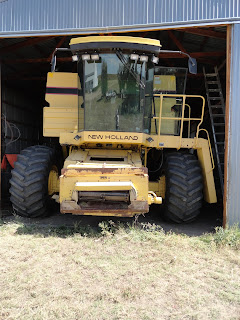Twenty Twenty-two proved that Eastern Colorado is the best next-year country in the world. Maybe a bit of an exaggeration. It was a disappointing year, farm-wise.
The wheat crop
was 38 bushels—not per acre. A total of
38 bushels, which sold for $300. The
price of wheat went as high as $10 per bushel.
None of us in the neighborhood had any wheat to sell. Typical!
I did raise a
bumper crop of sunflowers following the disastrous wheat crop.
Not much income
from that kind of sunflowers.
The millet crop
looked good.
It yielded a
little over 800 bushels, total, about five bushels per acre. That sold for $19.50 per hundred-weight. A hundred pounds equal two bushels.
Nothing to do
but plant next year’s wheat crop.
Keeping the weeds out of the summer fallow wasn’t too great a challenge,
given the dry conditions. But we did
have occasional rains throughout the summer, enough to bring the millet up.
A dry spell was
broken about mid-August. I actually
began planting wheat on the last day of August and finished before Labor
Day. That hasn’t happened for
decades.
When I was a
kid, the farmer I worked for started planting on August 21, unless that was a
Sunday. As the summers got hotter, the
planting date got pushed back.
Last year, I
planted in October. A lot of that wheat
didn’t come up until April. Some of it
either never came up, or sprouted and died in the drought conditions that
persisted throughout the winter of 2021-2022.
In August, I had
the moisture, so I planted. I have wheat
up this Fall!
The wheat was up
fairly well when it rained over an inch in less than 30 minutes. Thus, the mud in the lower part of the
picture. I should have a good stand next
spring when the winter wheat breaks its dormancy.
The wheat up, the
millet done, nothing to do but clean up and put stuff away.
There is always
some sadness, along with some relief, when it comes time to shut down for the
year. True, it is nice to be able to relax
a bit and look forward to days that don’t hit 100 degrees. But the summer is over and colder days loom
ahead.
This year, I
had to remove the old green machines to make room for the “new” stuff. The new combine is a 1995 model, a 30-year jump from the
old 1964 John Deere 95 combine.
Putting a
machine out in the open to rust away after it has been shedded during the
off-season for thirty years is a little like sending a trusty old work horse
from the stable to the glue factory.
Except for the
junk that always finds its way into a farm building, the shed was empty.
I had to remove
the top section of the combine’s exhaust pipe and the air intake apparatus to
get clearance under the doorway. It went
in.
Then the tractor,
and the trucks.
In the Fall, an
old man’s fancy turns to firewood. The
felled elm tree has been split and stacked.
There remain the smaller branches to be dealt with.
And look forward
to next year!
I live in a good “next
year” country.









No comments:
Post a Comment